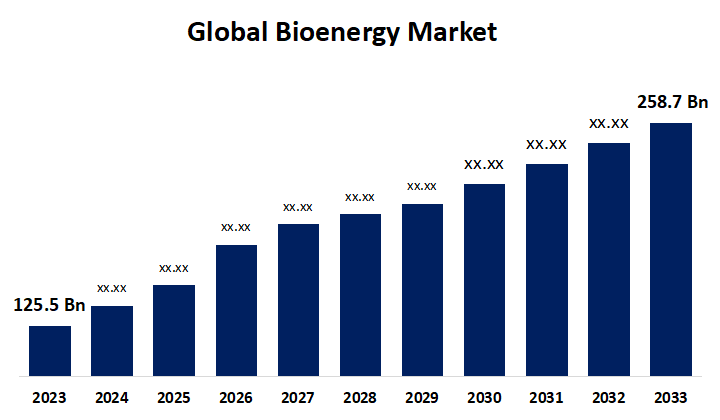Global Bioenergy Market Size, Share, and COVID-19 Impact Analysis, By Type (Biomass & Renewable Municipal Waste, Biogas, Liquid Biofuels), By Technology (Gasification, Fast Pyrolysis, Fermentation, Other Technologies), and By Region (North America, Europe, Asia-Pacific, Latin America, Middle East, and Africa), Analysis and Forecast 2023 - 2033
Industry: Energy & PowerGlobal Bioenergy Market Insights Forecasts to 2033
- The Global Bioenergy Market Size was Valued at USD 125.5 Billion in 2023
- The Market Size is Growing at a CAGR of 7.5% from 2023 to 2033
- The Worldwide Bioenergy Market Size is Expected to Reach USD 258.7 Billion by 2033
- Europe is expected to Grow the fastest during the forecast period

Get more details on this report -
The Global Bioenergy Market Size is Anticipated to Exceed USD 258.7 Billion by 2033, Growing at a CAGR of 7.5% from 2023 to 2033.
Market Overview
Bioenergy is a source of hope for our planet's long-term survival. It harnesses the power of nature by using organic materials such as plants, agricultural residues, and waste to generate clean, renewable energy. This environmentally friendly approach reduces greenhouse gas emissions and decreases our reliance on fossil fuels. One of its most significant benefits is its adaptability. It can generate electricity, heat, and even biofuels, allowing for a wide range of applications. Biomass power plants generate electricity efficiently, and biogas from organic waste can provide clean cooking fuel to communities around the world. It also contributes to economic growth by creating jobs in farming, forestry, and technology. It promotes rural development and helps local communities become self-sufficient in energy production. It is a sustainable solution to the world's energy crisis. Bioenergy can play a critical role in creating a greener, more sustainable world through responsible biomass resource management and ongoing technological innovation.
Report Coverage
This research report categorizes the market for the global bioenergy market based on various segments and regions forecasts revenue growth and analyzes trends in each submarket. The report analyses the key growth drivers, opportunities, and challenges influencing the global bioenergy market. Recent market developments and competitive strategies such as expansion, product launch, and development, partnership, merger, and acquisition have been included to draw the competitive landscape in the market. The report strategically identifies and profiles the key market players and analyses their core competencies in each sub-segment of the global bioenergy market.
Global Bioenergy Market Report Coverage
| Report Coverage | Details |
|---|---|
| Base Year: | 2023 |
| Market Size in 2023: | USD 125.5 Billion |
| Forecast Period: | 2023-2033 |
| Forecast Period CAGR 2023-2033 : | 7.5% |
| 2033 Value Projection: | USD 258.7 Billion |
| Historical Data for: | 2019-2022 |
| No. of Pages: | 200 |
| Tables, Charts & Figures: | 110 |
| Segments covered: | By Type, By Technology, By Region |
| Companies covered:: | Mitsubishi Heavy Industries Ltd, Hitachi Zosen Corp, BTG Biomass Technology Group, Enexor Energy, Drax Group, EnviTec Biogas AG, Pacific BioEnergy Corp, Lignetics, Enerkem, Green Plains Inc, Enviva, and Others Key Vendors. |
| Pitfalls & Challenges: | COVID-19 Empact,Challenges, Future, Growth, & Analysis |
Get more details on this report -
Driving Factors
Several developed and developing countries are implementing mandatory biofuel policies and setting biofuel targets to improve energy security and contribute to climate change mitigation, as well as to help develop the agriculture sector. Mandates and incentives for blending biofuels with fossil fuels contribute significantly to the continued growth of biofuel production and use. The majority of biofuels are currently consumed in combination with fossil fuels at low percentages. The demand for biofuel has increased significantly over the last decade as a result of policies such as the European Union's Renewable Energy Directive (RED) and the Fuel Quality Directive, which have regulated the required biofuel share for the transportation sector. Furthermore, Government policies and targets are expected to have a significant impact on bioenergy development. The most significant deployment is expected in areas with access to biomass resources and policies to phase out coal-fired boilers to improve air quality, which will drive demand for the bioenergy market.
Restraining Factors
The biomass supply chain is one of the most important drivers of large-scale bioenergy production. In many cases, obtaining initial funding for new developments on specific energy crops is a significant challenge. The majority of productions rely on complex transformation chains connected to feeding and food markets. The supply chain encompasses many different aspects, including biomass cultivation and harvesting, as well as treatment, transportation, and storage.
Market Segmentation
The global bioenergy market share is classified into type and technology.
- The biomass & renewable municipal waste segment is expected to hold the largest share of the global bioenergy market during the forecast period.
Based on the type, the global bioenergy market is categorized into biomass & renewable municipal waste, biogas, and liquid biofuels. Among these, the biomass & renewable municipal waste segment is expected to hold the largest share of the global bioenergy market during the forecast period. In this segment, biomass refers to waste that can be used to generate heat or power through combustion. Renewable municipal waste, on the other hand, is defined as organic garbage that includes rotten vegetables, fruits, and other food items. Organic waste, a subset of municipal solid waste (MSW), produces methane through processes such as pyrolysis/gasification, incineration, anaerobic digestion, and landfilling. There is an increase in waste-to-energy technology and demand for biomass. Anaerobic digestion and landfills produce biogas, which is primarily composed of methane and carbon dioxide. The use of biogas has several advantages over the use of various fossil fuels in a variety of applications, including domestic stoves, CHP plants, transportation, and various commercial services such as greenhouses, which drives market growth in the biogas segment.
- The fermentation segment is expected to hold a significant share of the bioenergy market during the forecast period.
Based on the technology, the global bioenergy market is categorized into gasification, fast pyrolysis, fermentation, and other technologies. Among these, the fermentation segment is expected to hold a significant share of the bioenergy market during the forecast period due to its mature and widely accepted technology around the world. Fermentation produces over 98% yield due to its widespread use in industry and processes that require low temperature and pressure, with alternative feedstock options such as Jatropha, animal fats, sludge, or waste cooking oil on the rise, combined with a commercial value of co-products and tax incentives on biodiesel; these technologies are gaining popularity in the early years of the forecast period. The biomass gasification segment's critical market consumers include small and large industries, the commercial sector, and rural communities.
Regional Segment Analysis of the Global Bioenergy Market
- North America (U.S., Canada, Mexico)
- Europe (Germany, France, U.K., Italy, Spain, Rest of Europe)
- Asia-Pacific (China, Japan, India, Rest of APAC)
- South America (Brazil and the Rest of South America)
- The Middle East and Africa (UAE, South Africa, Rest of MEA)
North America is anticipated to hold the largest share of the global bioenergy market over the predicted timeframe.

Get more details on this report -
North America is projected to hold the largest share of the global bioenergy market over the forecast period. Driven by technological advancements, abundant biomass resources, and a growing emphasis on renewable energy. The United States and Canada have been at the forefront of bioenergy adoption, particularly in the biofuels, biogas, and biomass power generation industries. Policies like the Renewable Fuel Standard in the United States have accelerated the growth of biofuels such as ethanol and biodiesel. The continent's emphasis on research and development has resulted in innovative solutions, such as cellulosic biofuels and waste-to-energy projects. With a commitment to lowering carbon emissions, improving energy security, and supporting rural economies, North America's bioenergy market is growing rapidly, demonstrating its leadership in the global transition to sustainable energy systems.
The Europe market is expected to grow at the fastest CAGR growth during the forecast period. The region's commitment to sustainability, strict environmental regulations, and innovative policies have fueled the development of bioenergy solutions. Europe makes significant investments in advanced technologies, such as biomass and biogas production, biofuel refining, and waste-to-energy conversion. The European Union's Renewable Energy Directive mandates increased bioenergy usage, encouraging member states to implement renewable solutions.
Competitive Analysis:
The report offers the appropriate analysis of the key organizations/companies involved within the global bioenergy market along with a comparative evaluation primarily based on their product offering, business overviews, geographic presence, enterprise strategies, segment market share, and SWOT analysis. The report also provides an elaborative analysis focusing on the current news and developments of the companies, which includes product development, innovations, joint ventures, partnerships, mergers & acquisitions, strategic alliances, and others. This allows for the evaluation of the overall competition within the market.
List of Key Companies
- Mitsubishi Heavy Industries Ltd
- Hitachi Zosen Corp
- BTG Biomass Technology Group
- Enexor Energy
- Drax Group
- EnviTec Biogas AG
- Pacific BioEnergy Corp
- Lignetics
- Enerkem
- Green Plains Inc
- Enviva
- Others
Key Target Audience
- Market Players
- Investors
- End-users
- Government Authorities
- Consulting And Research Firm
- Venture capitalists
- Value-Added Resellers (VARs)
Recent Developments
- In August 2023, Babcock & Wilcox announced a deal with General Hydrogen Corp., a CGI Gases subsidiary. According to the terms of the agreement, General Hydrogen Corp. will purchase net-negative carbon intensity hydrogen from a biomass-driven facility that uses B&W's innovative BrightLoop technology, which is currently being developed in Louisiana.
- In July 2023, Bunge (NYSE: BG) and Chevron Renewable Energy Group Inc., a subsidiary of Chevron Corporation (NYSE: CVX), acquired Chacraservicios S.r.l., an Argentine company, from the Italian Adamant Group. This strategic investment in innovative seed sources adds a new source of oil to Bunge and Chevron's global supply chains.
Market Segment
This study forecasts revenue at global, regional, and country levels from 2020 to 2033. Spherical Insights has segmented the global bioenergy market based on the below-mentioned segments:
Global Bioenergy Market, By Type
- Biomass & Renewable Municipal Waste
- Biogas
- Liquid Biofuels
Global Bioenergy Market, By Technology
- Gasification
- Fast Pyrolysis
- Fermentation
- Other Technologies
Global Bioenergy Market, Regional Analysis
- North America
- US
- Canada
- Mexico
- Europe
- Germany
- Uk
- France
- Italy
- Spain
- Russia
- Rest of Europe
- Asia Pacific
- China
- Japan
- India
- South Korea
- Australia
- Rest of Asia Pacific
- South America
- Brazil
- Argentina
- Rest of South America
- Middle East & Africa
- UAE
- Saudi Arabia
- Qatar
- South Africa
- Rest of the Middle East & Africa
Frequently Asked Questions (FAQ)
-
1.What is the CAGR of the global bioenergy market over the forecast period?The global bioenergy market is projected to expand at a CAGR of 7.5% during the forecast period.
-
2.What is the projected market size & growth rate of the global bioenergy market?The global bioenergy market was valued at USD 125.5 Billion in 2023 and is projected to reach USD 258.7 Billion by 2033, growing at a CAGR of 7.5% from 2023 to 2033.
-
3.Which region is expected to hold the highest share in the global bioenergy market?The North America region is expected to hold the highest share of the global bioenergy market.
Need help to buy this report?